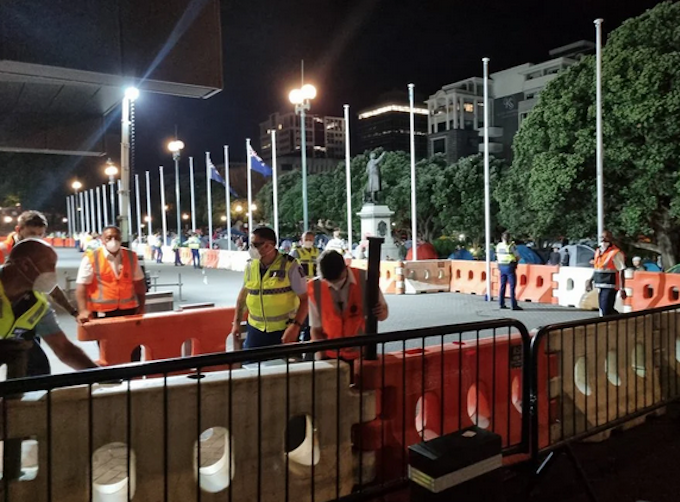
New Zealand police are braced as more protesters began arriving as the demonstration at Parliament in the capital Wellington entered the fourth day.
Tensions rose yesterday as the protest against covid-19 vaccine mandates continued, with police arresting 122 people who refused to leave Parliament grounds.
About a dozen police were on site this morning and a few dozen protesters were up and about on the grounds.
- READ MORE: Paris bans protest convoys inspired by Canada blockade
- RNZ News live updates on the Parliament protest
- Global media attacks on Australasian covid strictness ‘unfair’
- Yesterday’s third day updates
More barriers have been put up at the edge of the protest site on the lawn, and last night police installed floodlights on the forecourt.
They say it will take some time to remove everyone but Wellington District Commander Superintendent Corrie Parnell has promised the demonstrators will not be on the grounds for another week.
Watch what is happening outside Parliament:
Today’s protest happenings. Video: RNZ News
Wellington District Commander Superintendent Corrie Parnell said a number of vehicles parked illegally on Lambton Quay were moved.
He said police were repeating their order to the protesters to leave the area, as it was closed to the public and anyone remaining on the grounds was trespassing.
Expert warns protest may become ‘superspreader’
University of Otago professor of public health Dr Michael Baker told RNZ Morning Report the event had the potential to increase transmission of the virus, with protesters travelling from around the country and probably mixing with others outside their family group.
New Zealand’s Ministry of Health yesterday reported a record 306 community covid-19 cases as the omicron outbreak takes hold.
“That’s really the definition of a super spreading event and we know that’s how this virus gets around the world,” Professor Baker said.
“We’ve seen that already in New Zealand with the Soundsplash Festival in Hamilton. We’ve seen it a lot internationally at big gatherings.
“Even though it’s mainly outdoors, there will be a lot of indoor gatherings associated with it, you know, shared transport and accommodation, meals, the shouting and singing, which we know generates these aerosols,” he said.
“But the big extra problem here, of course, is that these groups, almost by definition, have low vaccine coverage low mask use. And they’re probably less likely to present for testing and self isolate if they’re sick.
“So all of those are really increasing the risks for this event.”
He said that after three days the point had certainly been made and any decision about whether to break the protest up would be a complex one, but it was currently presenting a risk.
This article is republished under a community partnership agreement with RNZ.













































